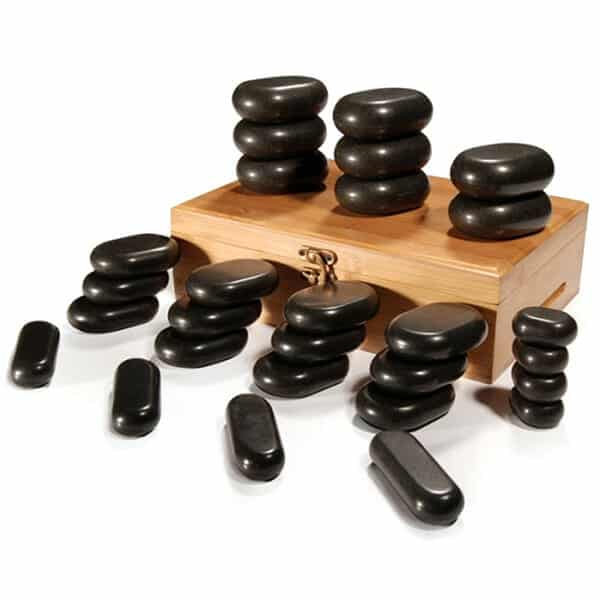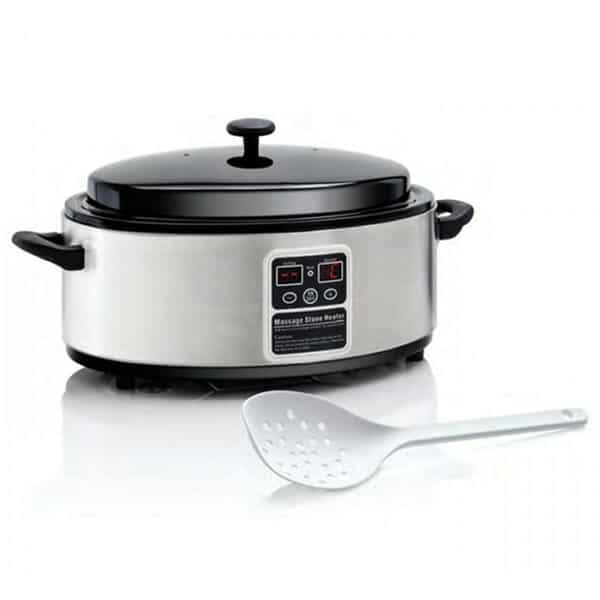
Hot and Cold Stone Therapy
This is an ancient massage technique utilising the benefits of contrast therapy (alternating hot and cold) or heat therapy (hot stone massage). Hot, smooth volcanic basalt stone with deep penetrating heat and cold marble stones are placed and used on the body throughout the massage restoring physical, emotional and spiritual wellbeing.
The earliest use of hot stones to improve health and relaxation took place in India among the Hindus, approximately 5,000 years ago and was called Ayurveda. This involved the placement of stones on the body to relax tense muscles and relieve related pain. Around 3,000 years later, the Chinese used shaped stones called Bian while burning Mugwort to treat disease. They also placed stones on the abdomen to improve digestion. Later, natives of the Sandwich Islands – what we now know as Hawaii – discovered that wrapping heated lava rocks in leaves and applying them to the body brought pain relief. The leaves were administered by medicine shamans called Kahunas.
Hot stone therapy is a useful addition to a massage therapist as it extends and enhances a massage without causing stress on the therapist’s joints and muscles. The stones are usually heated although cold stones are also used. Some therapists simply place the stones on the client in selected areas and perform a relaxation massage. Other therapists’ massage with the heated or cooled stones.
Different types of stones can be placed on the body in areas of significance to these approaches and the selected stone has a healing effect. For example, chakras are points in the body associated with physical or spiritual energy. Each chakra has a semi-precious stone associated with it and these are placed on the chakra to enhance healing of the energy.
Type of stone
Geologists classify rock according to how it is formed:
- Igneous rock
- Sedimentary rock
- Metamorphic rock.
Igneous rock is formed from molten rock or magma. The formation process can be beneath the earth’s surface in which case the rocks are referred to as intrusive igneous rocks. If the formation process is on the earth’s surface through volcanic activity, they are called extrusive igneous rocks.

Intrusive igneous rocks are formed by a slow cooling process and the crystals within them are large and prominent. The surface of the unpolished, natural rock is coarse. Granite is an example of this type of rock.
Extrusive igneous rocks are formed by volcanic activity and the lava cools quickly creating crystals that are smaller and finely grained. The unpolished surface is relatively smooth. Basalt which can range in colour from black to grey is a common extrusive igneous rock. The stone is usually tumbled by river or sea water and is smooth. The colour of the rock is due to the mineral content. For example, dark basalt has a higher content of elements such as iron and magnesium. Basalt stones easily absorb and retain heat; it is a commonly found rock, has an appealing range of colours and is relatively cheap. These factors make it the most popular type of stone used in stone therapy.
Basalt rocks retain a record of the earth’s magnetic field as it was when the rock was formed. It is thought that this magnetic field varies in orientation and strength over the life of planet earth. So, the orientation and strength of the magnetic field at the time that your basalt rock was formed can be analysed. For some that work in the stone therapy field these influences are powerful and can influence the body.
Quartzite is formed from sandstone that has been heated and recrystallised. It is smooth and has a satiny sheen. It is often lined with straight or curved markings and can be extremely attractive to look at. Brown, orange, red, brown, buff, green and black colours are reflections of the mineral content of the stone. For example, glauconite grains or ferrous iron can create the green form of this rock.
Marble is formed by the recrystallisation of limestone or dolomite. If the original limestone was nearly pure calcium carbonate, the marble will be white. However, many other colours exist and are influenced by the variation in the quantities of clay or sand in the original stone. The original stone is not in a form that can be used in massage and it must be cut, tumbled and shaped for use in massage. Marble is dense and smooth and easily retains heat or cold.

Shape & Size of the stone
The size and shape of the stones depends on what you use them for, the size of your hands and the area of the body you will apply them to. Some will be used for placement between toes (tiny stones) and others will be used to massage broad areas such as the thighs (large stones). The amount of stones you require will vary with your technique and experience. Most therapists start with a base collection of around 30 which they can easily use as they get used to this form of therapy. As your experience grows you may use up to 50 stones.
Texture
The texture must be smooth, some therapists prefer stones that are naturally smoothed by the action of river or sea water. Mechanically tumbled stones are available, but some therapists do not like them as they believe that the process of smoothing of the stone alters its electromagnetic potential and healing capacity.
In addition, mechanically tumbled stones can feel slippery in the hands especially when covered in oil. Slightly textured stones can be useful for exfoliation. Your preferences are individual and will change as you become proficient in the techniques.
Caring for stones
Once you purchase a set of stones you never have to replace them. However, you will have to care for them.
Storing stones is best done by immersing them in clean water in the stone heater. This way they do not dry out. There is no risk to the stone from the water and they are ready to be used at any time – you just have to turn the heater on to give them adequate time to heat before the massage.
Stones used for cold treatments should be stored in a covered plastic bowl filled with water.
If stones are not going to be used in the next 24 hours, then place them on a clean towel and allow to dry.
Cleaning stones must be carried out after every client. Cleanse with fresh water and an antibacterial soap. Rinse and place back into the heating unit. Turn the heater on again and boil the stones for a period of about 3 minutes. Then turn it down to the working temperature.
Some stones can become sticky and these can be cleansed with alcohol. The water in the heating unit only needs to be changed daily and you can add a sterilising solution to it. At the end of the day empty the heating unit of the stones. Place them on a dry clean towel and then empty the unit of the water. Dry the unit, spray with alcohol and wipe again. Refill the unit with water and add the stones. Do not turn on the unit until you need to for the next client.
Heating the stones
The stone heater should have a thermostat and a lid. Be careful when removing the lid as water will have condensed on the underside of the lid and can burn you. The working temperature should be between 43 to 60° C. This allows you to use the stones directly from the heater, always checking the temperature of the stone before using it in the treatment. The heater can be started at a higher working temperature and then reduced to the appropriate temperature for use on a client. However, allow sufficient time for the stones to reduce in temperature to the working heat. You always need to check the temperature before placing it on a client.
Benefits of hot stone therapy
- Helps muscles relax more quickly than a standard massage allowing you to work more effectively on areas of concern to the client.
- Increases blood and lymph circulation to the area
- Relaxes muscles relieving minor aches and pains
- Soothes the nervous system
- Reduces stress
- Can ease tension headaches and menstrual pain.
Benefits of cold stone therapy
- Decreases inflammation and swelling
- Stimulates the nervous system
- Eases sinus congestion and pain
- Eases arthritis pain
- Can ease pain caused by strains and soft tissue injuries
- Blood moves away from the area and into surrounding tissues.




















